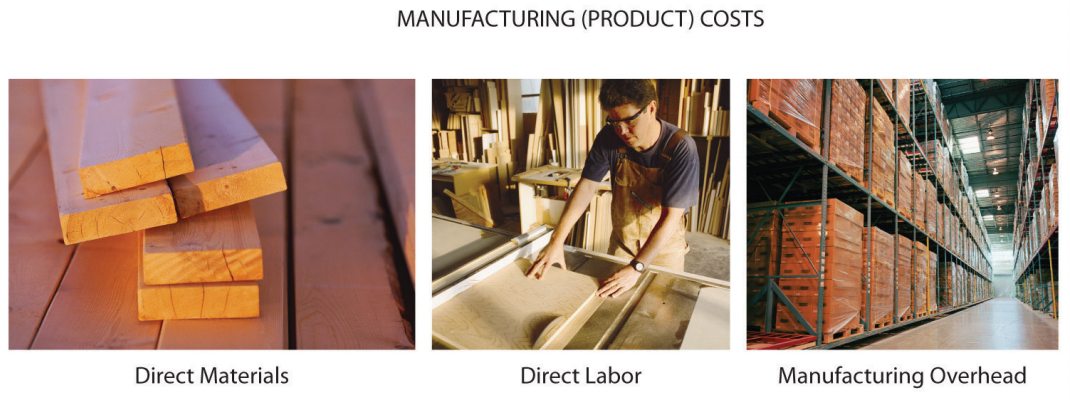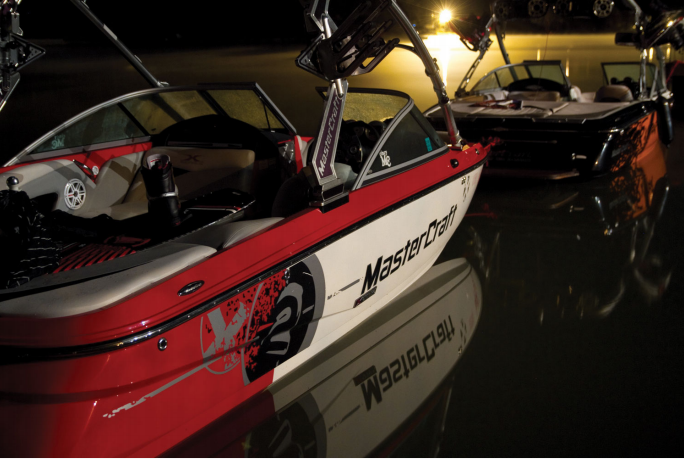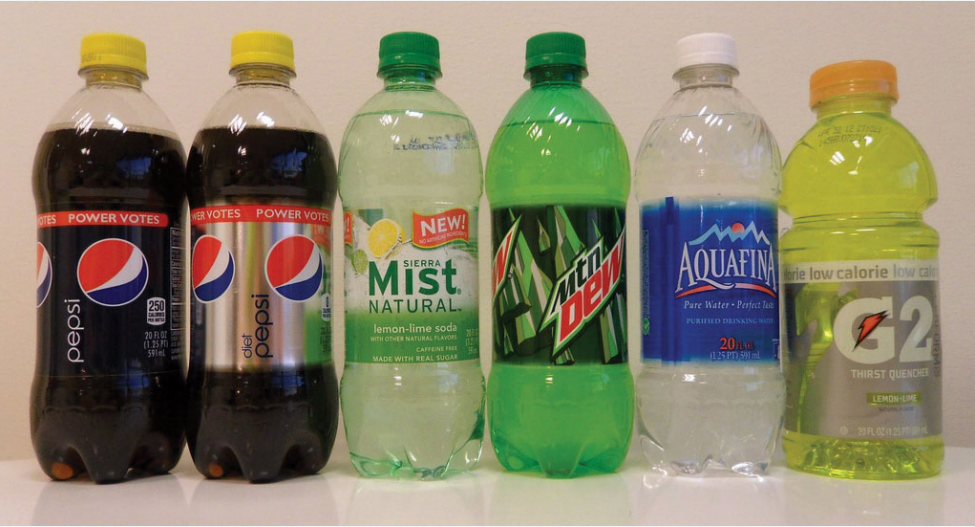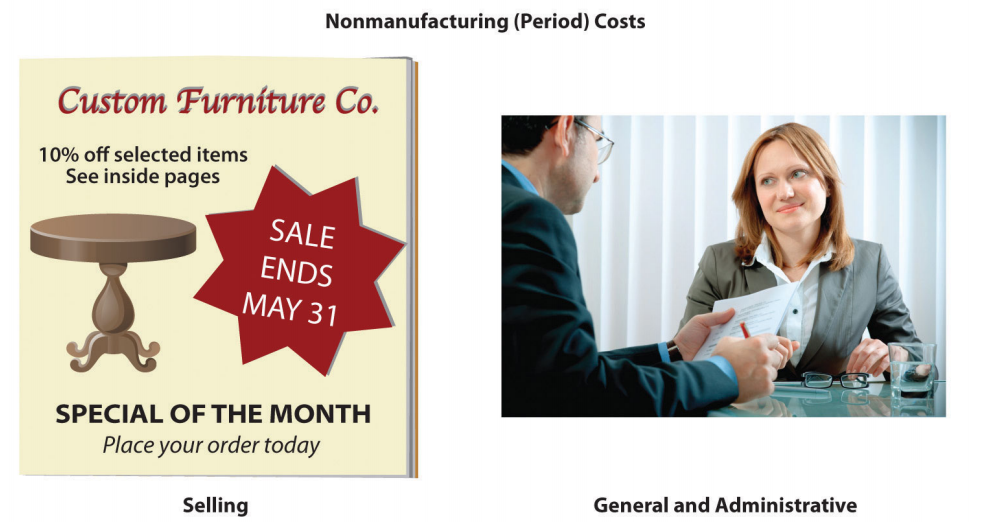7 2.7: Cost Terminology
Learning Objectives
- Understand the terms used for costing purposes.
Question: Much of what we discuss in this book relates to companies that manufacture products, such as Nike and Apple, and terminology is a key component of accounting for manufacturing companies. The challenge is in classifying costs correctly for items such as production materials, production labor, marketing department labor, rent for production facilities, and rent for the administrative services facilities. These costs must be classified accurately so that they appear correctly in company financial reports. The starting point for learning how to classify costs correctly is in understanding two broad categories of costs. What are the two broad terms used to categorize cost information in a manufacturing setting?
Manufacturing Costs
All costs related to the production of goods are called manufacturing costs16; they are also referred to as product costs. A manufacturer purchases materials, employs workers who use the materials to assemble the goods, provides a building where the materials are stored and goods are assembled, and sells the goods. We classify the costs associated with these activities into three categories: direct materials, direct labor, and manufacturing overhead.
To help clarify which costs are included in these three categories, let’s look at a furniture company that specializes in building custom wood tables called Custom Furniture Company. Each table is unique and built to customer specifications for use in homes (coffee tables and dining room tables) and offices (boardroom and meeting room tables). The sales price of each table varies significantly, from $1,000 to more than $30,000. Figure 2.4 shows examples of production activities at Custom Furniture Company for each of the three categories (we continue using this company as an example in Chapter 2).

Direct Materials
Question: Raw materials used in the production process that are easily traced to the product are called direct materials. What materials used in the production process at Custom Furniture would be classified as direct materials?
Direct Labor
Question: Workers who convert materials into a finished product and whose time is easily traced to the product are called direct labor. Who represents direct labor at Custom Furniture?
Manufacturing Overhead
Question: All costs associated with the production process other than direct material costs and direct labor costs are called manufacturing overhead. Terms synonymous with
Table 2.2 provides several examples of manufacturing costs at Custom Furniture Company by category.
|
Direct Materials
|
|
|---|---|
|
Direct Labor
|
|
|
Manufacturing Overhead
|
|
“Business in Action 2.5” details the materials, labor, and manufacturing overhead at a company that has been producing boats since 1968.
Business in Action 2.5: Manufacturing Costs at MasterCraft
MasterCraft produces boats for water skiers and wake boarders. Each boat produced incurs significant manufacturing costs. MasterCraft records these manufacturing costs as inventory on the balance sheet until the boats are sold, at which time the costs are transferred to cost of goods sold on the income statement.

Photo courtesy of Brian Miller, http://www.flickr.com/photos/13233728@N00/5155012186/
Examples of direct materials for each boat include the hull, engine, transmission, carpet, gauges, seats, windshield, and swim platform. Examples of indirect materials (part of
Source: MasterCraft, “Home Page,” http://www.mastercraft.com.
Nonmanufacturing Costs
Costs that are not related to the production of goods are called nonmanufacturing costs23; they are also referred to as period costs. These costs have two components— selling costs and general and administrative costs —which are described next. Examples of nonmanufacturing costs appear in Figure 2.5.
Selling Costs
Question: Costs incurred to obtain customer orders and provide customers with a finished product are called selling costs. (They are also often called marketing costs or selling and advertising costs.) What activities would be classified as selling costs at Custom Furniture?
Direct General and Administrative Costs
Question: Costs related to the overall management of an organization are called general and administrative costs26. What activities would be classified as general and administrative costs at Custom Furniture?
Figure 2.5 – Examples of Nonmanufacturing Costs at Custom Furniture Company
Although selling costs and general and administrative costs are considered nonmanufacturing costs, managers often want to assign some of these costs to products for decision-making purposes. For example, sales commissions and shipping costs for a specific product could be assigned to the product. This does not comply with U.S. GAAP because, under U.S. GAAP, only product costs can be assigned to products. However, as we noted earlier, managerial accounting information is tailored to meet the needs of the users and need not follow U.S. GAAP.
Distinguishing between manufacturing and nonmanufacturing costs is not always simple. For example, if legal staff works on an issue associated with production personnel and if human resources staff hires assembly line workers, are the costs involved manufacturing or nonmanufacturing costs? It is up to each organization to determine how to handle such costs for product costing purposes. The advantage of managerial accounting over financial accounting is that costs can be organized in any manner that helps managers make decisions. However, in this chapter, to avoid ambiguity, we follow the definitions provided by U.S. GAAP.
Presentation of Manufacturing and Nonmanufacturing Costs in Financial Statements
Question: At this point, you should be able to distinguish between manufacturing costs and nonmanufacturing costs. Why is it important to make this distinction?
Table 2.3 clarifies the relationship between manufacturing and nonmanufacturing costs. It also describes the point at which these costs are recorded as expenses on the income statement. (Remember that the terms manufacturing cost and product cost are interchangeable, as are the terms nonmanufacturing cost and period cost.)
| Manufacturing Costs (Also Called
Product Costs)
|
Nonmanufacturing Costs (Also Called
Period Costs)
|
|---|---|
|
|
| Timing of expense: Costs are expensed when goods are sold. | Timing of expense: Costs are expensed during the time period incurred. |
“Business in Action 2.6” provides examples of nonmanufacturing costs at PepsiCo, Inc.
Business in Action 2.6: Nonmanufacturing Costs at PepsiCo

Source: Photo courtesy of JeffBedord, http://www.flickr.com/photos/jeffbedford/6218820224/in/photostream/.
PepsiCo, Inc., produces more than 500 products under several different brand names, including Frito-Lay, Pepsi-Cola, Gatorade, Tropicana, and Quaker. Net sales for 2010 totaled $57,800,000,000, resulting in operating profits of $6,300,000,000. Cost of sales represented the highest cost on the income statement at $26,600,000,000. The second highest cost on the income statement—selling and general and administrative expenses—totaled $22,800,000,000. These expenses are period costs, meaning they must be expensed in the period in which they are incurred.
Examples of selling costs for PepsiCo include television advertising (probably the biggest piece of the $22,800,000,000), promotional coupons, costs of shipping products to customers, and salaries of marketing and advertising personnel.
Examples of general and administrative costs include salaries and bonuses of top executives and the costs of administrative departments, including personnel, accounting, legal, and information technology.
Source: PepsiCo, “PepsiCo 2010 Annual Report,” http://www.pepsico.com.
Key Takeaway
All manufacturing costs that are easily traceable to a product are classified as either direct materials or direct labor. All other manufacturing costs are classified as
Review problem 2.6
- The following manufacturing items are for a construction company working on several custom homes. Identify whether each item should be categorized as
direct materials, direct labor, or manufacturing overhead.
- Nails
- Lumber
- Drywall
- Workers building the house frame
- Supervisor responsible for three homes
- Light bulbs
- Cabinets
- Depreciation of construction equipment
- Identify whether each item in the following should be categorized as a product (manufacturing) cost or as period (nonmanufacturing) cost. Also indicate whether the cost should be recorded as an expense when the cost is incurred or as an expense when the goods are sold.
- Advertising
- Shipping costs for raw materials coming from a supplier
- Shipping costs for goods shipped to a customer
- Chief executive officer’s salary
- Production supervisor’s salary
- Depreciation on production equipment
- Raw materials used in production
- Paper used by the accounting staff
- Commissions paid to salespeople
- Janitorial services provided for production facility
- Supplies used by human resources personnel
- Utility costs for retail store
- Insurance costs for production facility
- Assembly line workers
- Clerical support for chief executive officer
- Maintenance of production equipment
- Identify whether each item listed in item 2 should be categorized as direct materials, direct labor, manufacturing overhead, selling cost, or general and administrative cost.
Definitions
- All costs related to the production of goods; also called product costs
- All costs related to the production of goods; also called manufacturing costs.
- Raw materials used in the production process that are easily traced to the product.
- Labor performed by workers who convert materials into a finished product and whose time is easily traced to the product.
- All costs associated with the production process other than direct material costs and direct labor costs.
- The costs of materials necessary to manufacture a product that are not easily traced to the product or that are not worth tracing to the product.
- The costs of workers who are involved in the production process but whose time cannot easily be traced to the product.
- Costs that are not related to the production of goods; also called period costs.
- Costs that are not related to the production of goods; also called nonmanufacturing costs.
- Costs incurred to obtain customer orders and provide customers with a finished product.
- Costs related to the overall management of an organization.



